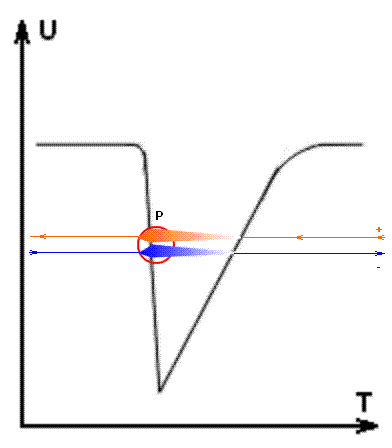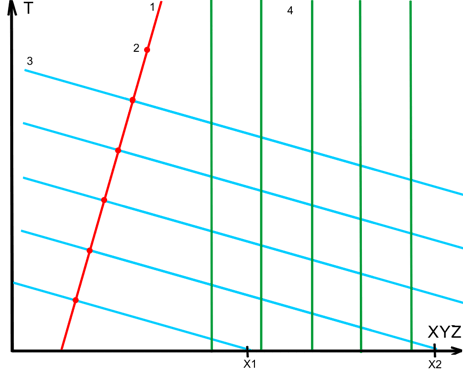Alexander A.Shpilman ( alexandrshpilman78@gmail.com )
Time - Overtime
(Continuation, the beginning see in N2/00 )
|
|
Let us assume that the electron is a fragment of the radiation flux
from the past to the future manifested in our gap now.
Suppose that the proton is a
fragment of the radiation flux from the future into the past manifested in our
gap now.
"Our gap now" is a certain
three-dimensional gravitational wave propagating along the axis of "our
time" T in the overtime O.
Let us assume that the difference in
the mass of an electron and a proton is due to the relativistic Doppler effect.
In this case, approximately:
|
|
mp/me = γ2 = 1/(1-(Vt/Co)2) |
(1) |
Here:
mp - is the proton mass,
me - s the mass of an electron,
Vt - is the speed of the time wave in
the OVERTIME,
Co - is the speed of light in the
OVERTIME.
Let us assume that Vt is equal to our speed of light C (in our "gap now"). Then
from formula (1) we have:
|
|
Co = C /
SQRT(1-me/mp) = 2.999* 108
m/s |
(2) |
It turns out that Co is greater than C by only 0.027%. Those, the speeds
are almost equal.
Let us assume that C is less than Co due to an increase in the refractive
index of the physical vacuum. In this version, we will try to determine what
difference in the refractive indices can give the difference in the masses of
the electron and proton due to reflection at the medium interface. Suppose that
the leading edge of the "now" wave is blurred as shown by the black
line in the graph in Fig.1. And the rear front represents a sharp boundary
between the "medium partition". Then the next fraction of the
radiation (relativistic effects are not taken into account yet) will pass into
our "now" through the boundary for the electron:
|
|
Ie = Io *(1 –
((n-1)/(n+1))2 ) |
(3) |
Here:
Io - is some initial radiation flux,
n - is the ratio of the refractive
index of the physical vacuum in our gap "now", with respect to the
refractive index of the physical vacuum in the outside.
For the proton, in our gap
"now", there will be an overlap of incoming radiation and reflected:
|
|
Ip = Io *(1 +
((n-1)/(n+1))2 ) |
(4) |
Let’s n is much greater than 1. Then:
|
|
Ie ~ Io *(2/n) Ip ~ Io *2 Ip/Ie
~ mp/me ~ n ~ 1833 |
It should be beyond our
"now" gap, outside the "wave of time" of our
"now" speed "light" Co is more in 1833 times our speed of
light C. If it so,
it is very encouraging for interstellar travel. This is the
"hyperspace" that fantasists like to dream about.
Naturally, the obtained figure is
very approximate. It, for example, is not taken reflection of radiation between
neighboring "time waves" into account and various nonlinear effects
are not taken into account.
***
|
Fig.2 |
A change in the speed of the
particle in the "now" along the XYZ
coordinates will lead to a change in the slope of the global line (Fig.2). In
this case, impulse of the particle becomes:
|
|
P12 = Po2 + PV2 |
(5) |
Where:
Po - is the initial momentum of the
particle,
PV - is transmitted by the particle
impulse of the motion along the XYZ
coordinates.
The speed C propagation of mass/energy along
the global line remains unchanged. If we start from the law of conservation of
momentum, it remains to assume that the mass of the particle changes. Then
equation 5 is transformed into:
|
|
(m1
*C )2 = (mo *C )2 + (m1 *V )2 |
(6) |
Where:
V - is the speed of particle along the
coordinates XYZ,
mo - is the mass of "rest"
particle,
m1 - is the mass of particle with speed
V.
If we solve equation 6, we get:
|
|
m1 = mo /SQRT(1 - (V/C)2)
= γ * mo |
(7) |
The relativistic change of the mass
particle arise by itself.
Waves
of de Broglie
We find in the handbook on physics
the formula for determining the wavelength of de Broglie, the particle of mass m with the speed
of motion V:
|
|
λ = h /(
γ*m*V) |
(8) |
Where:
h - is the constant of Planck.
We should note that speed is the
relative magnitude of the objects of interaction, and not absolute speed
relative to the "Universe navel" (even if it is the experimenter
himself). We will try to derive formula 8,
based on our model. We assume that the frequency of the wave process in the
"global line" of the particle is equal to:
|
|
fo = (mo*C2)/(2*h) |
(9) |
|
|
The numerator is divided into two
because in the "global line" we have a straight and reflected wave in
our gap "now". And it is unlikely that our gap "now" is
similar to a moving glass. Most likely this wave is of change the physical
properties of the vacuum. Accordingly, a straight and reflected wave forms a
standing wave along the global line of particle 1 (the red line in Fig. 3) with
nodes of antinode 2 (red dots on line 1) spaced at a distance:
|
|
lo = Co
/ (2*fo ) = h/ (mo*C) |
(10) |
The coordinate system in Fig.3 is
tied to the crystal lattice. The global lines 4 (green) of its atoms are shown
in this figure.
We show the convergence of our test
particle with the crystal lattice by the slope of the global line 1 to the
global lines 4.
The phase planes of a standing wave
3 in 1 cross the "now" line of the crystal at points X1, X2, ... The distance between these points is equal
to:
|
|
Lo = X2 - X1 = lo /(V/C)=
lo * Co / V = h/ (mo*V) |
(11) |
For the relativistic case:
|
|
λ = Lo
/ γ = h /( γ*mo*V) |
(12) |
Exactly, this is characteristic
length of wave (the de Broglie wave). It will characterize the diffraction of
the moving particle at the sites of the crystal lattice.


